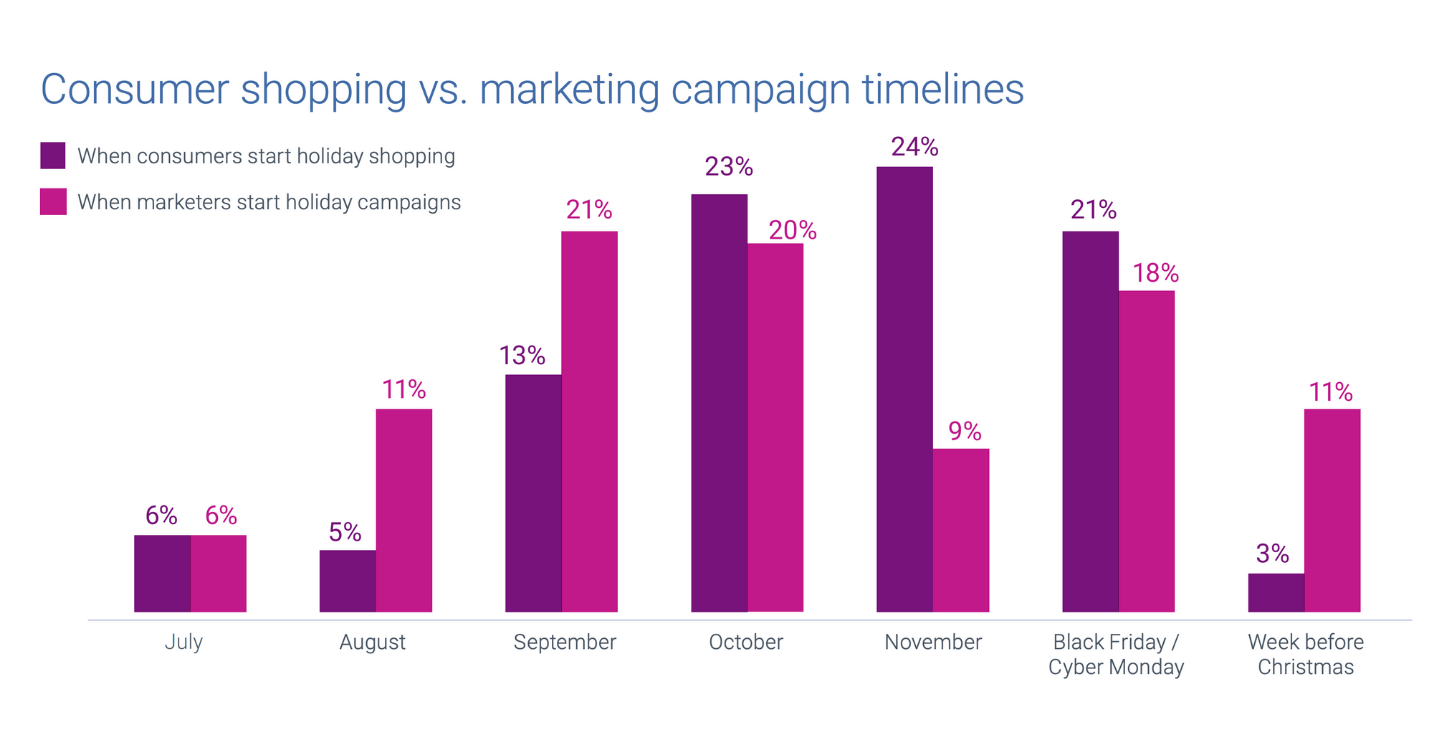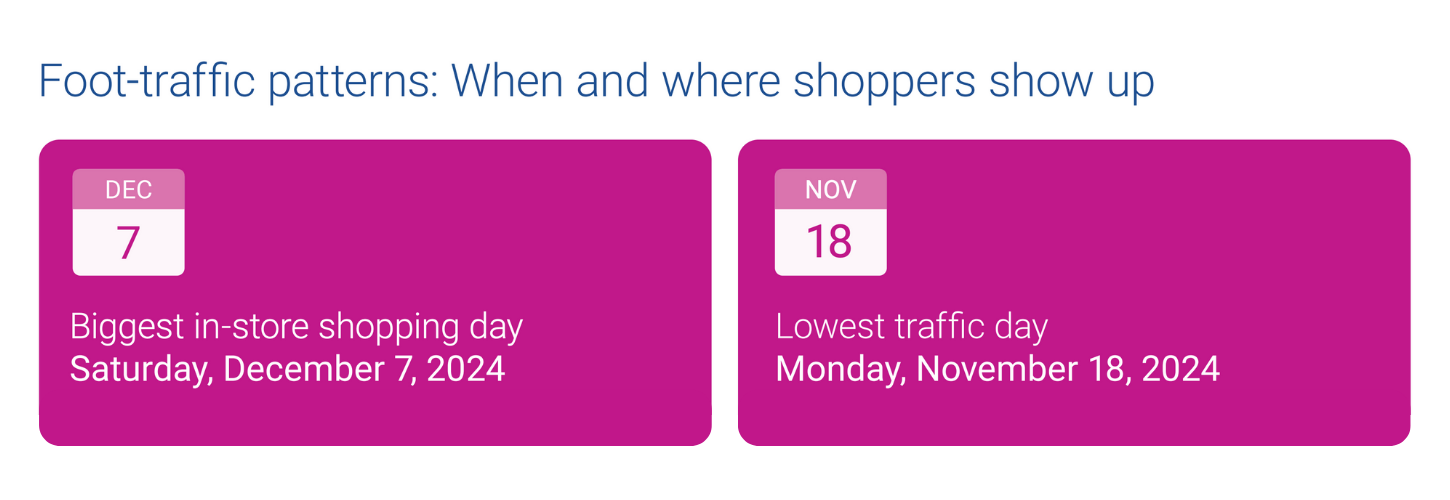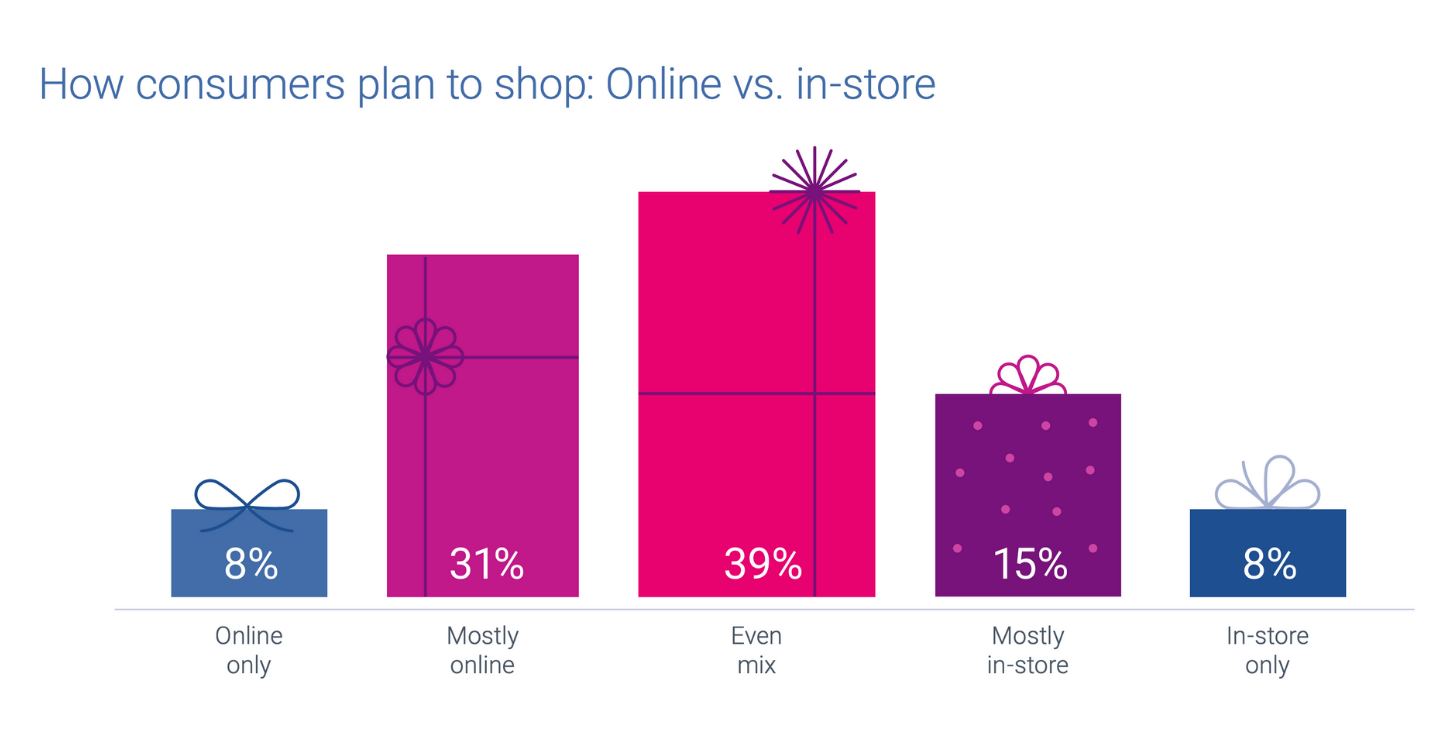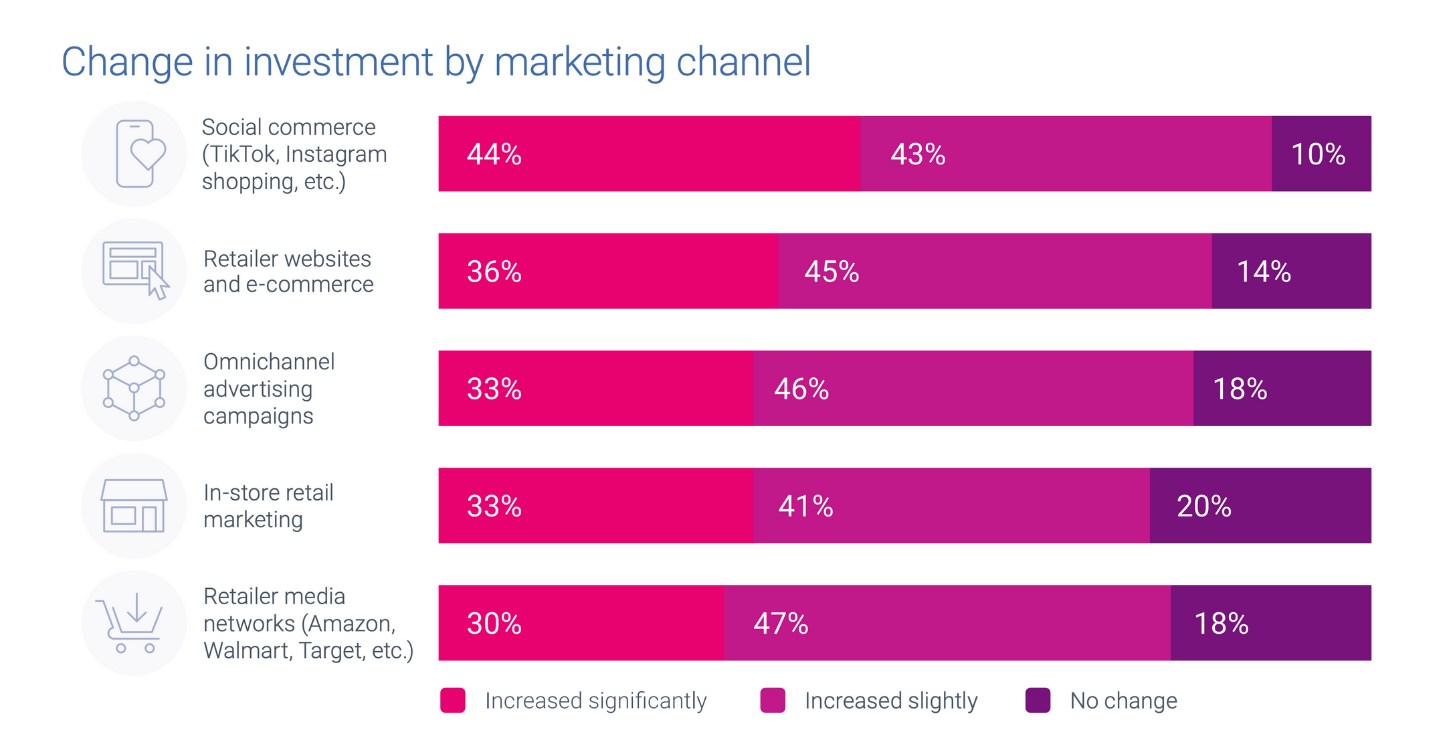At A Glance
Holiday shopping in 2025 doesn’t follow one clear pattern, with shoppers blending early planning and last-minute purchases, digital discovery and in-store validation, and cautious spending. Marketers who embrace this complexity, by staying relevant, consistent, and connected across channels, will be best positioned to win this season.Holiday shopping in 2025 feels a lot like a complicated relationship. Shoppers want deals, but they also want trust. They start shopping early, but they’re still browsing well into December. They love the convenience of online shopping, but they still show up in-store before making the final call.
Our 2025 Holiday spending trends and insights report, created this year in collaboration with GroundTruth, explores these contradictions. Our findings show that this year’s holiday season isn’t about one big shift; it’s about managing the push and pull between what consumers say, what they do, and how marketers respond.
Here are three complicated truths you need to know.
Experian’s 2025 Holiday spending trends and insights report
Optimize your 2025 holiday shopping campaigns with our latest report with GroundTruth.
Download now1. The new rules of holiday timing
Almost half (45%) of consumers plan to start shopping before November, but 62% admit they’ll still be buying in December. And post-holiday shopping (think gift card redemptions and deal-hunting) remains a real factor.


Why it’s complicated
The holiday calendar isn’t what it used to be. There’s no single “big moment” anymore. Instead, shoppers are spreading purchases across months, peaking around the “Turkey 12” (the 12 days surrounding Thanksgiving) and again in the final December rush.
What to do about it
- Stretch your campaigns across the full season, not just Cyber Week.
- Refresh offers to stay relevant as shopper motivations change from deal-seeking to last-minute urgency.
- Watch for post-holiday momentum and extend your promotions into January.
How belVita nailed the timing
In celebration of National Coffee Day, belVita partnered with GroundTruth on a one-month campaign to boost product awareness and drive foot traffic to Target stores. By utilizing digital out-of-home (DOOH) and mobile ads powered by location, behavioral, and purchase-based targeting, the campaign achieved a 3.44% visitation rate, nearly $476k in products added to carts, and a low cost-per-visit of just $0.22.
2. Online leads, but in-store still seals the deal
Nearly 40% of shoppers say they’ll split their purchases between online and in-store and 80% of consumers still prefer the in-store experience. Only a small fraction plan to shop exclusively in one channel. That means while digital often starts the journey, the final decision often happens in a physical store.

Why it’s complicated
Shoppers love the convenience of browsing online, but they still want the reassurance of seeing, touching, or testing products before buying. In-store isn’t just about the transaction, it’s the validation step.
What to do about it
- Build omnichannel strategies that connect digital discovery with in-store follow-through.
- Use location and identity data to tie digital impressions to real-world actions, like foot traffic and purchases.
- Focus on consistency: shoppers expect the same value, tone, and trust whether they’re on a website, in an app, or standing in a store aisle.
How Duke Cannon used on-premise targeting to drive sales lift
Duke Cannon, a premium men’s grooming brand, partnered with GroundTruth to launch a successful multichannel campaign utilizing location-based and behavioral audience targeting across CTV and mobile screens to drive in-store visits and sales.
By targeting consumers with mobile ads while they were physically in-store, the company capitalized on high purchase intent, aiding in the 12% sales lift. This strategic approach resulted in over 43.9k provable in-store visits and a significant increase in sales.
3. Marketers double down, consumers hold back
This holiday season, expectations are split. 66% of marketers expect holiday spend to rise, but only 22% of consumers agree. While brands are leaning into bigger investments across CTV, retail media, and social, shoppers are staying cautious, weighing value and waiting for the right deal.

Why it’s complicated
That disconnect introduces risk. If marketers don’t align spend with real consumer behavior, budgets can get wasted in the rush to cover every channel. Shoppers haven’t stopped spending, but they’re spending differently. They’re trading down to discount and big-box retailers while cutting back in discretionary categories like apparel and restaurants.
What to do about it
- Prioritize efficiency by focusing on the right audiences, not just more impressions.
- Make consistency your advantage: reach people once and connect across platforms instead of chasing fragmented signals.
- Balance aggressive media investment with messaging that acknowledges consumer caution — shoppers want value and trust, not hype.
Measuring TV and streaming impact with iSpot
iSpot’s Audience Builder, powered by Experian’s Marketing Attributes, helps brands reach high-value audiences. During the holiday season, a luxury retailer could target $100K+ households with affluent lifestyle interests. With iSpot’s Unified Measurement platform, they can track performance across linear TV and streaming and shift spend in real time to maximize results.
The bottom line on 2025 holiday shopping trends
This year’s holiday shopping season is, well…complicated. Shoppers are cautious but still engaged. They’re early planners and last-minute browsers. They want the ease of digital, but the confidence of in-person.
For marketers, the opportunity lies in embracing that complexity, not trying to simplify it away. The brands that balance relevance, trust, and convenience across the full season and across every channel will be the ones that win.
Download our full 2025 Holiday spending trends and insights report to explore all five shifts shaping this season and see how you can turn complexity into opportunity.
About the author

Fred Cheung
Director, Partnership Sales, Audigent, a part of Experian
Fred Cheung has spent over a decade in the programmatic advertising space, with roles at Mindshare, Jounce Media, Twitter, and The Trade Desk. His deep experience in trading and product management helps in his current function on the Experian Marketing Services’ Sales team where he focuses on data growth and adoption across the industries’ leading buy-side platforms.
2025 holiday shopping trends FAQs
Because consumer behavior is full of contradictions. People will shop earlier but also later, browse online but purchase in-store, and want deals while demanding trust. Marketers need to navigate these push-and-pull dynamics.
Nearly half (45%) say they’ll start before November, but 62% admit they’ll still be buying in December, with momentum even continuing into January through gift card redemptions and deal-hunting.
Although many consumers begin online, the majority still make their final decisions in-store. In-person shopping acts as a validation step where customers can see, touch, or try products before buying.
Instead of focusing only on Black Friday or Cyber Week, marketers should stretch campaigns across the full season, refresh offers frequently, and continue promotions into January.
Not entirely. 66% of marketers expect spending to rise, but only 22% of consumers agree. Shoppers are cautious, prioritizing value and often trading down to discount or big-box retailers.
An omnichannel approach using identity and location data can bridge digital impressions with real-world actions like store visits and purchases, ensuring consistency across touchpoints.
Brands like belVita and Duke Cannon successfully tied digital campaigns to in-store results by utilizing precise audience targeting, location data, and well-timed promotions.
You can download Experian’s 2025 Holiday spending trends and insights report to explore all five shifts shaping this season.
Latest posts

We’re excited to introduce the next segment in our Q&A series, Ask the Expert! Ask the Expert features a series of conversations with product experts where we dive into the areas you care most about like identity resolution, targeting, attribution, and more. Our next segment features a conversation about sell-side targeting. Mike Chowla, SVP of Product at OpenX joins us to chat with Experian’s SVP of Sales & Partnerships, Chris Feo. OpenX is the world's leading sell-side platform for audience, data, and identity targeting. In their conversation, Mike and Chris review: The shift to targeting on the sell-side How first- and third-party data are being used on the sell-side How OpenX is thinking about alternative IDs Watch the recording What is sell-side targeting? Sell-side targeting optimizes the way buyers and supply-side platforms (SSPs) work together. This approach moves the responsibility of inventory and audience targeting from the demand-side platform (DSP) into the SSP, providing advertisers with increased reach and better performance. With sell-side targeting, locating your target audience becomes easier as you have a more direct connection with publishers. This increases your ability to scale against a target audience. Specifically, the SSP directly matches the buyer's audience or data segment to the publisher inventory and audience and automatically sends the impression to the buyer's DSP of choice via a deal ID, providing advertisers with improved reach and performance metrics as well as control over their inventory. With more direct access, your budget can likely go further, and you can decrease your effective cost per mille (eCPM) and get more working media. "Supply-side targeting is the next phase of how supply path optimization (SPO) and buyers will need to work more closely with SSPs." – Mike Chowla, SVP, Product, OpenX Buying on the sell-side vs. open exchange When buying on the open exchange, you have access to a vast number of impressions. With sell-side targeting, you can apply your campaign targeting directly on the supply-side and activate those impressions through a deal ID. Sell-side targeting works across various formats including web display, mobile, in-app, and connected TV (CTV) for a seamless advertising experience. OpenX offers the unique capability to match users using their device graph within their SSP. This means you can target users from traditional data sources such as cookies or mobile ad IDs (MAIDs) and reach them in CTV or app environments. This gives you even more reach and precision in your advertising efforts. The role of first- and third-party data on the sell-side Buyers are showing a keen interest in bringing their own first-party data into the process of sell-side targeting. Meanwhile, certain agencies have been actively involved in working with identity and data. OpenX is currently collaborating with several agency ID solutions such as Choreograph, Merkel, and Horizon. Buyers are also purchasing third-party data and data segments from various providers through OpenX's platform for sell-side targeting purposes. By utilizing this data on the supply side, buyers are able to increase the match rate against their first- and third-party data segments in all environments. This ultimately maximizes scale against these audiences and drives a more efficient CPM due to eliminating waste. Measurement and attribution on the sell-side In the current state of SSP advertising, there is more of an emphasis on targeting capabilities than measurement and attribution. That said, SSPs can provide granular log level reports that can be utilized for multi-touch attribution (MTA) or mixed media models (MMM). These granular insights not only inform measurement and attribution models, but they also provide valuable optimization insights such as clearing price. Additionally, advertisers have all of the same reporting options that they’re used to getting through their DSP because their buys are activated via deal ID in the DSP of their choice. What to consider when transitioning to sell-side targeting There are two primary items you should consider when transitioning to sell-side targeting: Supply Reach Reach Collaborating with partners who have the right capabilities can greatly improve reach and audience extension across different devices. For instance, if you bring your first-party audience or a third-party audience and are identifying that consumer via a cookie or MAID, being able to extend that targeting segment to other devices and platforms can be highly beneficial. Supply It's crucial to collaborate with partners who have the right access to supply and direct connections with publishers. While targeting is essential, it's equally important to have high-quality supply to drive performance. Reaching consumers in a cookieless future Whether you're targeting on the demand or sell-side, it always starts with the consumer and who you're trying to reach. Significant changes in the consumer privacy landscape are impacting advertisers' ability to access various signals emitted by consumers through their devices and browsers. Recent developments from Apple and Google have further amplified this situation. Alternative IDs as a solution to signal loss In response, we're seeing the emergence of alternative IDs like UID2, Ramp ID, and ID5. OpenX supports these types of IDs and considers them crucial for audience buying in a privacy-centric cookie-less future. We are still in the early stages of this evolution. While some of the IDs have good coverage, cookies will continue to be the primary targeting method as long as they remain available. Nevertheless, we see alternative IDs as one of several solutions that will become increasingly important as third-party cookies disappear. Contextual buying will also emerge, and a set of solutions will come together to enable advertisers to keep finding their audience in a cookie-less world. Overcoming signal loss with identity resolution Looking ahead, as we continue to lose signals due to the evolving consumer privacy landscape, we will witness two things: Continued fragmentation A wide variety of identifiers Content will continue to be available on various devices. We're currently experiencing the emergence of connected TV, but who knows what other devices will surface over the next five to ten years. As cookies disappear, which have been the primary identifier, and alternative IDs are introduced, the wide variety of identifiers will create further fragmentation. This highlights the need for identity in the future. Identity resolution at Experian matches fragmented identifiers to a single profile to create a unified, cross-channel view of your consumers. Our identity resolution solutions can help future-proof your marketing strategies. How Experian and OpenX work together Experian is a key player in OpenX's OpenAudience solution and helps to power many of their data segments as well as their identity graph. While OpenX collaborates with a variety of providers and operates a fully interoperable platform, Experian remains valuable to the core technology within OpenX's SSP. "Experian powers a lot of the data segments and identity graph that OpenX has in our OpenAudience capabilities as part of our SSP." – Mike Chowla, SVP, Product, OpenX Watch the full Q&A Visit our Ask the Expert content hub to watch Mike and Chris's full conversation on sell-side targeting. In the Q&A, Mike and Chris also share their thoughts on the impact artificial intelligence (AI) will have on the AdTech industry and their go-to sources for staying up to date on all things AdTech. Watch now Get in touch About our experts Mike Chowla, SVP, Product, OpenX Mike Chowla is the SVP of Product at OpenX where he leads product development and innovation, from customer discovery and user research to the development, delivery, and support of a market-leading product suite. Chowla holds a BS in Engineering from the University of Southern California, and an MBA from The University of Pennsylvania. Chris Feo, Chief Business Officer, Experian As SVP of Sales & Partnerships, Chris has over a decade of experience across identity, data, and programmatic. Chris joined Experian during the Tapad acquisition in November 2020. He joined Tapad with less than 10 employees and has been part of the executive team through both the Telenor and Experian acquisitions. He’s an active advisor, board member, and investor within the AdTech ecosystem. Outside of work, he’s a die-hard golfer, frequent traveler, and husband to his wife, two dogs, and two goats! Latest posts

As Earth Day approaches, it’s the perfect opportunity for marketers to explore innovative ways to engage with eco-conscious customers. With a strong and growing interest in sustainable business practices worldwide, green audiences are becoming increasingly influential. In addition to being good for the planet, engaging these customers is great for any brand or organization striving to become more eco-friendly and socially responsible. By taking advantage of this timely event and using appropriate tools, you can create personalized campaigns that will both promote your brand and increase customer loyalty. Eco-conscious audiences In this blog post, we'll cover three eco-conscious audiences to target this Earth Day: Solar energy GreenAwareTM Electric vehicles Solar energy Our first eco-conscious audience is Solar energy. Consumers in this audience show an inclination toward harnessing the power of the sun as a clean, renewable energy source. Our audience data can provide valuable insights into the Solar energy consumer base, including their age, education level, occupation, household income, and communication preferences. Let's explore these metrics to better understand how to reach this group effectively. Age and living situation Consumers in our Solar energy audience are more likely to live in a home with two or more adults and are between the ages of 45-74. Education level and occupation Consumers in our Solar energy audience are more likely to have graduated from college or graduate school and work in management-level occupations. Household income Consumers in our Solar energy audience have household incomes of more than $75,000 and their homes are valued at over $550,000. Preferred engagement channels Consumers in our Solar energy audience are most receptive to ads served through digital channels like digital newspapers and email. Solar energy audience pairings Consumers in our Solar energy audience also belong to three of our Mosaic® USA groups: Power Elite Flourishing Families Booming with Confidence Our consumer segmentation portal of 126 million households and 650 lifestyle and interest attributes empowers marketers like you to precisely target your ideal audience and communicate with them on a personal level. Mosaic’s data segments the U.S. into 19 overarching groups and 71 underlying types, giving you the insights needed to anticipate the behavior, attitudes, and preferences of your most profitable customers and communicate with them on their preferred channels, with messaging that resonates. GreenAware Our second eco-conscious audience is GreenAware. GreenAware segments the 126 million U.S. households within Experian Marketing Data into four distinct groups. Each group differs in their attitudes and behaviors toward purchasing products that are environmentally safe and working with companies that are eco-conscious. We created these groups using an enhanced application of traditional statistical clustering techniques based on environmentally relevant measurements in Simmons' National Consumer Study. Based on the distinctive mindset of consumers toward the environment, you can learn how environmental concerns fit into their lives through four major consumer segments: Eco-Friendly Enthusiasts Sustainable Spectators Passive Greenies Eco Critics Let's dive deeper into each group to understand their unique perspective on the environment and how this impacts their attitudes and behaviors. Eco-Friendly Enthusiasts This eco-conscious segment prioritizes a green lifestyle and takes pride in avoiding products that harm the planet. With traditional and liberal values, they embrace optimism and prioritize family. With their children out of the house, they take the time for some well-deserved rejuvenation and are committed to a healthy lifestyle. Some members of this group are transitioning into retirement and welcoming a new chapter in their life. Mature adults and retirees College graduate or more Above average income May be married or single Typically own their homes Sustainable Spectators This segment aspires to be more sustainable, but they struggle with translating their green ideas into action. They have a soft spot for a cozy home. While their love for interior design and taking care of their own space is evident, they're always looking for new experiences and opportunities to learn. Staying healthy and active is a top priority for this group, so it's no surprise that they're always looking for ways to stay fit and feel their best. Established and mid-life adults College graduate or more High income Typically married Likely to own their homes Passive Greenies This is the largest and one of the most youthful groups. Known for their love of exploration and self-discovery, they may not have fully embraced eco-conscious behaviors yet, but they are eager to stay current with the latest technology and trends. With their incredible ability to multitask, they're always on-the-go, and constantly seek the next best thing. Mainly young adults and diverse Education ranges from high school through some college Below average income More likely to be single or divorced Typically rent Eco Critics This group is not likely to be eco-conscious and may have negative attitudes about the environment. They are confident, driven, and focused on their personal growth. They crave instant gratification, seeking out quick and easy solutions to their everyday decisions. They place a high value on entertainment, their social life, and carefully curate their image. Young and established adults Education ranges from high school through post-graduate studies High income Married or single Typically own their homes Let's take a look at how the GreenAware segments stack up against each other in terms of age, household income, education level, and media preference. How do they compare? Let's find out. Age Consumers in the Eco-Friendly Enthusiasts segment are the oldest of the four GreenAware segments – about half of the consumers are 65 or older. Eco Critics are the youngest segment, with over half of consumers in this group between ages 25-44. Household income Sustainable Spectators and Eco Critics are the wealthiest GreenAware segments. The average household income of consumers in these segments is above $100,000. Passive Greenies have the lowest household income, with a majority below $50,000. Education level and occupation Passive Greenies are more likely to work Blue Collar jobs and have the lowest level of education. As the wealthiest segments, Sustainable Spectators and Eco Critics have the highest levels of college degrees and work in management, business, and financial operations. Eco-Friendly Enthusiasts are the most likely to be retired and out of the workforce. Preferred engagement channels Streaming TV is the preferred engagement channel for all GreenAware segments. Eco-Friendly Enthusiasts prefer digital channels like digital newspapers, mobile SMS, and email. They also engage with traditional channels like direct mail and newspaper. Passive Greenies have a high preference for digital display, mobile SMS, digital video, broadcast cable TV, and radio. Eco Critics have a high preference for digital channels like digital newspapers, mobile SMS, and digital display. Sustainable Spectators strongly prefer digital newspapers. They don't show as strong of a preference for mobile SMS and digital display as Eco Critics and Passive Greenies. GreenAware audience pairings Six of our Mosaic groups have at least one GreenAware segment with 10% or more of the population. For more precise targeting, below are suggested Mosaic audiences you can pair with each GreenAware segment: Eco-Friendly EnthusiastsSustainable SpectatorsPassive GreeniesEco CriticsBooming with ConfidencePower EliteSingles and StartersPower EliteAutumn YearsBooming with ConfidenceGolden Year GuardiansSuburban StyleGolden Year GuardiansSingles and Starters Electric vehicles Our third eco-conscious audience is electric vehicles. Electric vehicles (EVs) are having a major moment in the automotive industry. This is no surprise given that new EV models are being released and an increasing number of charging stations are popping up around the country. As EVs become more prominent, it's essential to stay up to date on relevant trends to make informed decisions about what lies ahead. The demand for electric vehicles (EVs) is on the rise Consumers are embracing the EV revolution, showing their desire for a cleaner, greener future. Automotive marketers are increasingly looking to reach in-market EV shoppers and current alternative fuel vehicle owners due to the growing availability of electric vehicles, improved infrastructure, and rising popularity. In 2022, EVs charged up the market and accounted for a remarkable 6% of new retail registrations. While Tesla continues to dominate the EV market, Ford, Chevrolet, and Hyundai are starting to compete, each holding more than 3% of the market share of new retail EV registrations. Geography Where are we seeing the most new retail EV registrations? The top designated market areas (DMAs) for new retail EV registrations are mostly located in heavily populated, coastal cities like Los Angeles, CA and New York, NY. The fastest growing DMAs, however, are in smaller cities like Tucson, AZ and Oklahoma City, OK. Generational demographics Gen X and Millennials make up the largest percentage of new retail EV buyers at 37.5% and 34.4%. Gen Z and the Silent generation represent the smallest shares at 5% and 2.1%. Boomers hover between Gen X and Millennials' share and account for 20.6% of new EV retail purchases. EV audience pairings Our top five Mosaic groups for new EV buyers include: American Royalty Cosmopolitan Achievers Philanthropic Sophisticates Couples with Clout Fast Track Couples How to target consumers in-market for electric vehicles We offer 70+ audiences that are focused on likely buyers and owners of EV and plug-in hybrid (PHEV) vehicles. We also offer a subset of 28 audiences focused on individual EV/PHEV vehicle models. Below is how you can find a few of these audiences on-the-shelf of most trusted advertising platforms: Autos, Cars, and Trucks > In Market-Fuel Type > Electric Autos, Cars, and Trucks > In Market-Fuel Type > Used Electric Autos, Cars, and Trucks > In-Market Make and Models > Tesla Autos, Cars, and Trucks > In-Market Make and Models > Chevrolet Bolt EV We can help you reach eco-conscious consumers Earth Day is a great opportunity to get creative with your marketing efforts with our three eco-conscious audiences: Solar energy, GreenAware, and electric vehicles. To find out how you can add eco-conscious audiences to your marketing plan, contact us. Get in touch Latest posts

Advertisers are always looking for ways to improve the targeting and effectiveness of their campaigns. One strategy that's gaining popularity lately is using curated private marketplace (PMP) deals, allowing advertisers to buy premium ad inventory in a private auction environment. But how do data providers and PMPs work together to make PMP advertising more successful? What is a private marketplace (PMP)? Advertising PMPs, or private marketplace deals, are a type of programmatic advertising where advertisers and publishers negotiate and set up a direct deal between themselves to buy or sell advertising inventory in a private auction environment. In PMP deals, publishers can make their premium inventory available to a select group of advertisers, who can bid on it in a private auction using demand-side platforms (DSPs). These private auctions typically offer higher-quality inventory and a more targeted audience than open exchange auctions, which are accessible to all advertisers. However, traditional PMPs had their limitations, including often being limited to accessing inventory from a single publisher group. Audigent takes PMP advertising to the next level with SmartPMPs Audigent's key differentiator is that instead of activating audience data from the DSP, which is the industry standard, they integrate directly with supply-side platforms (SSPs). By taking this route, audience data and inventory from hundreds or even thousands of publishers can now be packaged together into a single deal ID / SmartPMP. SmartPMPs empower media buyers with the ability to access and buy against unique, customizable data segments on premium curated publisher inventory in combinations that otherwise would not have been available. Activating data via the supply-side also enables supply-side optimizations. This means that instead of simply being a data provider, Audigent plays an active role in the success of media buyers' programmatic campaigns by optimizing toward performance goals in coordination with demand-side buyers. The result is the full alignment of demand- and supply-side technologies for the first time in programmatic. SmartPMPs drive campaign performance Audigent performance data compared to the programmatic open exchange: How Experian and Audigent partner in PMP advertising Experian and Audigent collaborate using Consumer View audience data. By supplying valuable insights into users' interests, behaviors, and demographics, we help advertisers create more targeted and personalized ad campaigns with Audigent. This can lead to higher engagement rates, greater brand awareness, and increased conversions for Audigent and Experian clients. By activating Experian data via Audigent SmartPMPs, advertisers unlock the ability to reach highly engaged users across premium, curated inventory sources on key channels like connected TV (CTV), display, video, and more. Unlock the potential of programmatic advertising with us Our strategic collaboration with Audigent is transforming the programmatic advertising space. Our partnership enables our customers to tailor their ads directly to their desired audience. This elevated personalization results in higher conversion rates and optimized campaigns for superior ROI performance. Contact us for more information about our digital audience segments on the Audigent platform. To learn more about our partner Audigent, visit www.audigent.com. Contact us Get in touch Latest posts